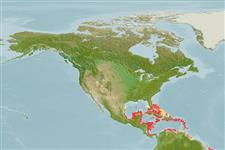Klassifizierung / Names
Namen | Synonyme | Catalog of Fishes(Gattung, Arten) | ITIS | CoL | WoRMS | Cloffa
Environment: milieu / climate zone / depth range / distribution range
Ökologie
seewasser riff-verbunden; tiefenbereich 12 - 35 m (Ref. 9710). Tropical
Western Central Atlantic: southern Bahamas, Hispaniola and the Virgin Islands to Venezuela.
Size / Gewicht / Alter
Maturity: Lm ? range ? - ? cm
Max length : 12.0 cm TL Männchen/unbestimmt; (Ref. 9710)
Kurzbeschreibung
Bestimmungsschlüssel | Morphologie | Morphometrie
Rückenflossenstacheln (insgesamt) : 21; Rückenflossenweichstrahlen (insgesamt) : 12; Afterflossenstacheln: 2; Afterflossenweichstrahlen: 22; Wirbelzahl: 37 - 38.
Inhabits deeper reefs with abundant algae (Ref. 9710). May be easily approached (Ref. 9710).
Life cycle and mating behavior
Maturities | Fortpflanzung | Spawnings | Egg(s) | Fecundities | Larven
Lieske, E. and R. Myers, 1994. Collins Pocket Guide. Coral reef fishes. Indo-Pacific & Caribbean including the Red Sea. Haper Collins Publishers, 400 p. (Ref. 9710)
IUCN Rote Liste Status (Ref. 130435)
Bedrohung für Menschen
Harmless
Nutzung durch Menschen
Tools
Zusatzinformationen
Download XML
Internet Quellen
Estimates based on models
Preferred temperature (Ref.
123201): 26.4 - 28, mean 27.6 °C (based on 40 cells).
Phylogenetic diversity index (Ref.
82804): PD
50 = 0.5078 [Uniqueness, from 0.5 = low to 2.0 = high].
Bayesian length-weight: a=0.00490 (0.00196 - 0.01224), b=3.09 (2.87 - 3.31), in cm total length, based on LWR estimates for this (Sub)family-body shape (Ref.
93245).
Trophic level (Ref.
69278): 3.9 ±0.7 se; based on size and trophs of closest relatives
Fishing Vulnerability (Ref.
59153): Low vulnerability (10 of 100).
Nutrients (Ref.
124155): Calcium = 112 [58, 174] mg/100g; Iron = 0.7 [0.4, 1.2] mg/100g; Protein = 18.4 [17.3, 19.4] %; Omega3 = 0.102 [0.059, 0.175] g/100g; Selenium = 28.3 [12.6, 58.3] μg/100g; VitaminA = 143 [48, 422] μg/100g; Zinc = 1.87 [1.24, 2.62] mg/100g (wet weight);
